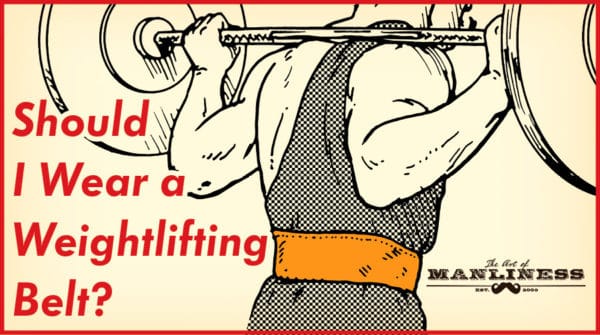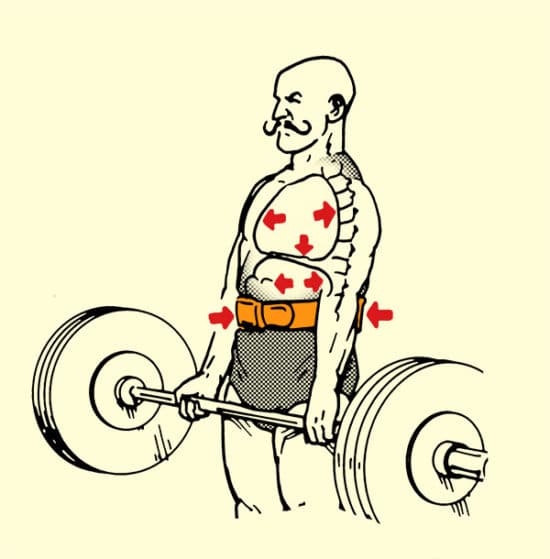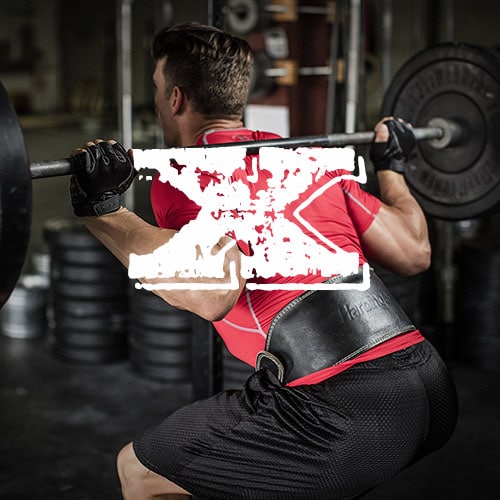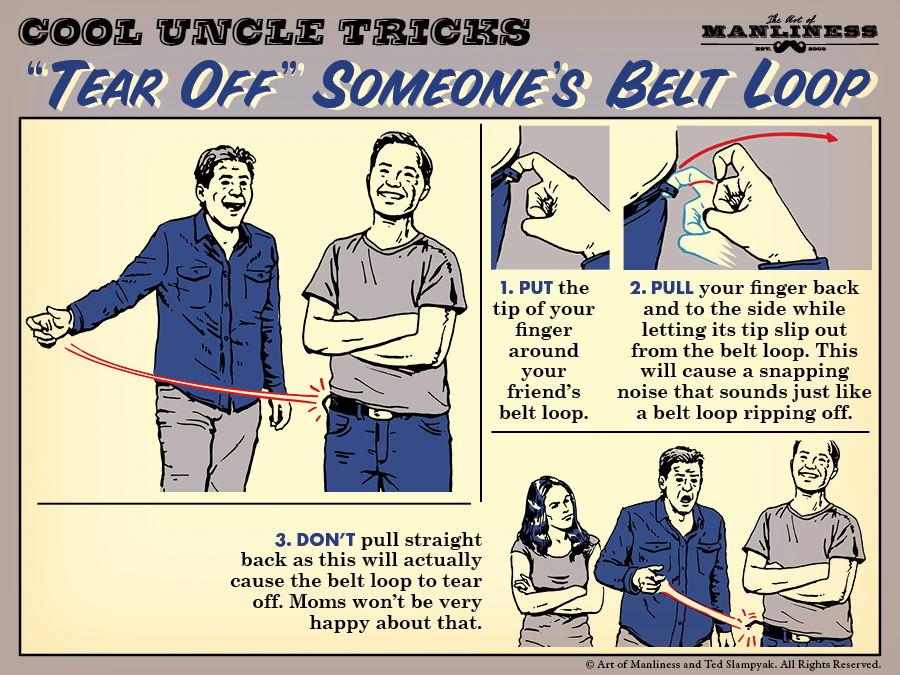
If you’ve begun the righteous path of seeking gainz via barbell training, you may be wondering: “Do I need to wear a belt when I lift?”
The short answer is this: yes, at a certain point in your barbell training you should start wearing a belt.
For the longer answer, I talked to Matt Reynolds, my barbell coach and head of the Barbell Logic Online Coaching, to give us the ins and outs of when, why, and how to wear a weightlifting belt.
What do weightlifting belts actually do?
A common assumption about weightlifting belts is that they act as an external support to help you lift heavier weight than you could through your natural strength alone. Consequently, many guys see weightlifting belts as a crutch — “cheating” or “wussy” or “insert your favorite insult here.”
Another assumption is that a weightlifting belt acts as a brace on your lower back, protecting it and preventing the rupturing of a disc.
As to the first idea: no, weightlifting belts will not magically allow you to lift more weight.
As to the second: weightlifting belts do help so that you don’t injure yourself while lifting heavy weight, but it’s not the belt itself that provides the bracing.
How do belts work then?
Before we get to that answer, we need to take a step back and understand proper body mechanics when you’re squatting, deadlifting, or pressing heavy weight.
In everyday conditions, your torso, or “core,” is sponge-like: soft and flexible. This flexibility is what allows you to bend side to side or forwards and backwards and twist with ease.
But this sponge-like pliability comes at a cost to strength. When you’ve got 350 pounds on your shoulders for a squat, you don’t want a torso that’s sponge-like — it would just collapse. Rather, you want a torso that’s hard and rigid like a telephone pole.
To get this tree trunk-esque torso, you need to brace your core. Without having to think about it, your body naturally does this whenever you’re lifting or pushing something heavy. Mark Rippetoe uses the example of pushing a car to highlight this instinctive response. Think back to when you’ve had to push a stalled car. You took a big breath and held it while simultaneously tightening the muscles in your core. When you hear someone say, “Brace yourself!” you probably will hold your breath and flex your core muscles too.
Holding your breath in conjunction with tightening your torso creates a lot of internal pressure in your core that turns your typically spongy center into a rigid and strong telephone pole-like structure. This pressure and tightness allows you to lift or push heavier weight more efficiently and without injuring your spine.
(There’s a lot more we could get into about the mechanics of this breath holding + torso tightening dynamic, but for our purposes here, the above summary suffices. We’ll be doing a detailed follow-up on why you should hold your breath — aka the Valsalva maneuver — when lifting in a later article.)
Okay, so when we lift heavy weight, we need a rigid torso, and we get that rigid torso by holding our breath and tightening our core muscles.
What does this have to do with weightlifting belts?
As I said above, the weightlifting belt itself doesn’t provide support to your back. It doesn’t act like some sort of exoskeleton that makes your back magically stronger simply by putting it on.

Illustration inspired by diagram in Starting Strength.
What the weightlifting belt does do is provide a proprioceptive cue to your torso to squeeze and tighten your core muscles harder when you’re lifting a really heavy weight. Just as you can tense your bicep muscles more when you’re curling 20lb dumbbells than when you’re curling a couple of soup cans, your core muscles can tense up more when they’ve got something to push against. The weightlifting belt provides that pushback.
So instead of directly supporting your torso, a weightlifting belt indirectly supports it by providing feedback to your core to tighten and make itself as rigid as possible.
So, the next time some Instagram dudebro tells you weightlifting belts are cheating, you can tell him what’s what.
Now that you know what a weightlifting belt does, let’s get into the specifics of when and how you should wear one.
What kind of weightlifting belt should I get?
Knowing that weightlifting belts provide a cue to your torso muscles to tighten when lifting heavy will provide guidance into the kind you should wear.
If you go to most fitness stores, the only weightlifting belts you’ll typically see have a large padded strap that covers the small of your back and skinny leather straps for the front. This type of weightlifting belt is the kind I used for years.

Don’t use this kind of weightlifting belt.
These belts were designed with the idea that the purpose of the belt is to directly provide support for your lower back. Or as Rip says, “These belts were designed by people who don’t understand the purpose of a weightlifting belt.”
In theory, that big, large padded back strap is supposed to act like a brace. But we know that instead of bracing the back, weightlifting belts actually provide a cue to our torsos to flex as hard as they can. Thus the big-in-the-back, small-in-the-front design on these belts doesn’t provide uniform feedback to your torso; it will have more area to push against in the back than in the front, which could result in a less rigid core. What’s more, the big back on these belts gets in the way of lumbar extension which makes it difficult to set your lower back in the correct position when you’re deadlifting or squatting, which in turn can result in a less efficient lift and even injury to your lower back.
Ironic, isn’t it?

With that in mind, a proper weightlifting belt has the same width all around the waist. There’s no goofy-looking larger back.
Most weightlifting belts are 4” wide. For the majority of guys with average body proportions, this will suffice. One drawback on the 4” wide belt for folks with an average torso length, however, is that getting in the proper deadlifting position can be a bit uncomfortable, as the belt has a tendency to dig into your ribs.
For this reason, Matt recommends that most folks get a 3” belt. It will provide sufficient torso feedback when squatting and is comfortable even when deadlifting. A 3” belt is also more comfortable to wear than a 4” belt when performing Olympic lifts like the clean and snatch.
If you have a shorter torso, and longer legs, definitely get a 3” belt because anything wider will be uncomfortable to fit between your ribs and hips both when squatting and deadlifting.
Besides getting a weightlifting belt that is the same width all the way around, here are some other factors to look for when buying a belt:
All leather. A leather belt is durable and strong and will last you a lifetime. Many belts on the market are made from nylon. They just don’t hold up as well as leather belts.
Thick. A nice thick belt gives your core more to push against. The maximum thickness belts come in is about 13mm; get that size.
Prong or lever buckle. Many cheap-o weightlifting belts on the market use Velcro to cinch and keep the belt in place. Two problems with Velcro: 1) Velcro doesn’t last forever, and 2) if you’re really tensing that core, sometimes Velcro just won’t stay together. It’s happened to me: During a heavy deadlift at my local globo-gym, I used the crappy Velcro weightlifting belt they had hanging around. Right in the middle of the lift, the Velcro gave out. Threw my lift for a loop.
Instead of Velcro, go with a weightlifting belt with a prong buckle or a lever closure device. If you go with the prong buckle, find something with a single prong. They’re just easier to put on and take off than a double-prong belt.
Lever closure devices make putting on and taking off a belt a breeze. The downside is that adjusting the belt for tightness is a pain because you have to unscrew the lever from the belt, adjust, and then screw it back on again.
Look to spend at least $100 on your belt. It might seem like a lot of cash, but a good belt will last you a lifetime.
For a solid 3” weightlifting belt with a single-prong buckle, check out BestBelts.net. This is what I use.
If you’d like a 4” wide weightlifting belt, you can’t go wrong with Rogue Fitness’s single-prong Ohio Lifting Belt. Pioneer Fit also makes a quality 4” wide, single-prong belt.
If you’re looking for a belt with a lever closure device, Pioneer Fit offers one in the 4” size.
When should I wear a weightlifting belt?
You’ve probably been to the gym and seen some middle-aged dudebro walking around with his weightlifting belt on while stopping occasionally to do some leg presses or dumbbell shoulder presses.
Don’t be like this guy.
A weightlifting belt should be used judiciously and only when you really need one, and you only really need one whenever there’s a heavy load on your spine. The only exercises where you experience this kind of load are barbell lifts like squats, deadlifts, strict presses, and the various Olympic lifts.
You don’t need to wear a belt when you’re curling or using any machine because there’s no load on the spine when you’re doing those movements (in fact you don’t need to be using a machine, period). You also don’t need to wear a belt when you’re bench-pressing; by lying down on a bench, you’ve taken the load off your spine. Matt said, however, that you could wear a belt during the bench press to provide some feedback to remind yourself to take a big breath and hold it while performing the lift.
Alright, so we’re only going to use a belt when we’ve got a heavy load on our spine. At what point is a load considered “heavy”? If you’re just starting out with barbell training, you can probably get away without using a belt while lifting for a few weeks or months. The load just isn’t heavy enough to necessitate a belt. You can create enough tension in your core to perform the lift safely without the feedback it provides.
For the main barbell lifts, Matt recommends that you bring in the belt once you can squat your bodyweight, deadlift 1.5X your bodyweight, and shoulder press .75X your bodyweight. Before then, just go beltless.
These are only general guidelines, not hard and fast rules, mind you. Experiment and figure out what’s best for you.
Once you’ve introduced the belt to your training, you don’t want to wear it all the time. For your warm-up sets, go beltless until your last set. At that point, put on the belt, do your last heavy warm-up set, and then keep it on for the rest of your working sets. Feel free to loosen your belt between sets.
Where should I wear my weightlifting belt?
To provide the appropriate feedback and comfort during the lift, wear your belt directly over your navel. You may need to adjust things based on the lift. For example, on deadlift, because you bend over, you may notice the top of your belt digging into your ribs. If that happens, lower the belt slightly.
How tight should I wear my weightlifting belt?
Tighter than you think it needs to be. Most beginning lifters don’t put on the belt tight enough, so err on the side of too tight. Take a normal breath in and then pull the belt as tight as possible — as tight as you can make it without it interfering with your breathing.







